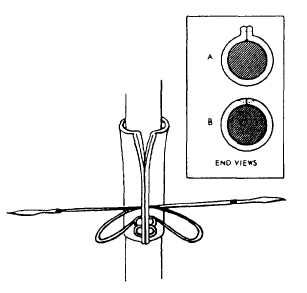| |
eyelet down over the spur. Do not pound too hard on the
punch because that causes the grommet to cut through
the canvas and later it may pull out.
The eyelet and ring type of grommet is especially
for awnings and sails. Properly used, this is the best of
all types. The ring part is sewn to the canvas the same
as the handmade grommet. Then the eyelet is placed in
the ring and set with the punch and die.
LEATHER
LEARNING OBJECTIVES: Define leather:
Explain the use and care of leather.
Hides and skins, being of animal origin, vary in
area, thickness, and weight. Subsequent tanning and
finishing processes further alter these features. The
following information concerning the areas, thickness,
and weights is, therefore, only approximate.
The types of leather include rigging, harness, shoe,
chamois, kid, lacing, belting, and various artificial
leathers. Of these, the three you are most likely to need
are rigging, belting, and artificial leathers.
Rigging leather is designated by weight as light,
medium, or heavy, ranging from 6 ounces per square
foot to 10 ounces per square foot. It is issued by the
pound.
Belting is either round or flat and is issued in any
desired length by the linear foot. Round belting comes
in two widths, 1/4 inch and 3/8 inch. Width is used
instead of diameter because, despite the name, it is oval
rather than round. Flat belting may be either single- or
double-ply. Single-ply belting is in 1- to 6-inch widths;
double-ply, 2- to 12-inch widths.
The most common types of artificial leathers are
used for upholstery and are issued by the square foot.
CARE OF LEATHER
Leather exposed to the elements should be kept
well oiled or waxed. Any oil that does not contain harsh
chemicals is suitable, but the best is neat's-foot oil.
Leather in such places as on lifelines may be kept
well-preserved by the application of paste wax. Saddle
soap, an excellent preservative and cleaner, can be used
on holsters, and on shoes, jackets, and other leather
wearing apparel. If leather becomes badly soiled and
stained, wash it with a mild soap and water solution,
rinse well, and dry in a spot away from intense heat.
After it is dry, apply saddle soap or neat's-foot oil to
replace the natural oils of the leather.
Leather is especially subject to mildew and rotting.
It is also highly susceptible to accidental cutting,
gouging, and abrading. Excessive heat causes it to
shrink considerably, with consequent rending and
cracking. Acids, corrosives, or their fumes have a
disastrous effect upon leather.
The foregoing conditions should be borne in mind
when stowing leather. Rolls must have top stowage to
prevent crushing. Stowage must be well clear of any
liquids or greases that might stain. To prevent sticking,
paper should be placed between hides stowed one on top
of the other. Original moistureproof wrappers should be
left on as long as possible to prevent mildew. Stowage
should always be in a dry, well-ventilated compartment.
SEWING LEATHER
On leather, the line along which the stitches are to
run on each edge should be grooved so as to countersink
the stitches below the surface. When joining two pieces
of leather by sewing by hand, first draw a line parallel
and close to the edge first, then make your groove with
a grooving tool (a dull knife will do). Use a block of
wood for a straightedge. Next, punch holes along the
grooves for the stitches.
The shoemaker's or cobbler's stitch is shown in
figure 3-40. A variation of this stitch is to cut the leather
carefully so that the edges abut. Angle the grooves
toward the edges of the leather and sew through the
Figure 3-40.–Shoemaker's stitch.
3-29
|

